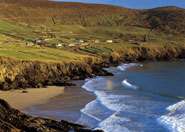New historical perspective on Irish economy

Susan Flavin, a PhD student in the Department of Historical Studies, studied Bristol customs accounts and port books to investigate the range of commodities that were imported into Ireland from Bristol towards the end of the sixteenth century.
She found that there was a dramatic increase in the range and volume of luxury goods imported: from just 60 basic items in 1503 to almost 400 by 1600. These findings are surprising because Ireland in the 16th century, which is still seen by economic historians as a colonial backwater, is a very unlikely place to find significant changes of this nature. (It is widely accepted that the ‘birth’ of a consumer society in Britain did not occur until the 18th century, in line with growing industrialisation and commercialisation.)
The customs accounts and port books of Bristol are an outstandingly detailed record of Anglo-Irish trade, recording in minute detail what was the most important branch of Ireland’s overseas trade. The records are particularly invaluable because the public records office in Dublin was destroyed in 1922. No other economic records of equivalent value survive in Ireland, or elsewhere, for examining the country’s economic development during this period.
The nature of the Irish economy in the sixteen century meant that Ireland remained dependent on imports for the vast majority of every-day goods; the accounts therefore paint a very detailed picture of the evolving nature of Irish material culture and of changing patterns of consumption.
By examining the custom accounts, Susan Flavin found that growth occurred in two main areas: the increasing diversification of product types (buttons, for example, evolved from a single category to a large range of subtypes) and the appearance of entirely new items such as soap and spectacles, an increasing variety of luxury European cloth and foods, and a range of items described as being specifically for children.
However, while one might expect the growing range of luxury items to reflect increasing wealth in Irish society, the overall value of the Bristol-Ireland trade seems to have collapsed at the same time as luxury imports increased. It seems that while the variety and, in some cases, the volume of small luxury items was going up, there was a corresponding fall in staple goods such as broad cloth, saffron and raw silk, which together made up the largest part of the gross value of import trade in the first half of the century.
In order to understand this dichotomy, Flavin examined Ireland’s exports, in addition to its imports (the accounts record both), and found evidence of well-developed Irish mercantile contacts with Spain. For example, in 1594 Irish merchants exported four times more Spanish hat wool to England than they did Irish wool, and by 1600, Seville oil made up 11 per cent of Irish exports to Bristol.
This suggests that Irish merchants were being increasingly drawn towards European markets, which would partly explain the decreasing value of Ireland’s trade with England.
Susan Flavin said: “My research does not suggest that 16th century Ireland showed all or even many of the features of a modern consumer society, or that it underwent a ‘consumer revolution’ of the type claimed by historians of 18th century Britain. Nevertheless, analysis of the Bristol customs data points to a dramatic shift in the nature of Irish consumption by the last quarter of the 16th century, indicating both a growing sophistication of tastes and an increasing prosperity in Ireland.”
More information: 'Consumption and material culture in sixteenth-century Ireland' by Susan Flavin in Economic History Review (2010)
Provided by University of Bristol















